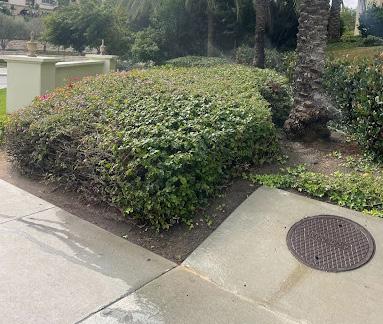
6 minute read
Students take a stand against sexual assault
from Volume 60 Issue 21
CARE and Center for Health and Wellness commemorate Denim Day
ANJALI DALAL-WHELAN ASST. NEWS EDITOR
Advertisement
Trigger warning for mentions of sexual assault and rape.
USD students and many people around the world observed the 24th “Denim Day” a day of advocacy and awareness for sexual assault prevention on April 26. USD’s Denim Day was sponsored by Campus Assault Resources and Education (CARE) and USD’s Center for Health and Wellness. The day marked USD’s last event of Sexual Assault Awareness Month (SAAM), following a multitude of other events including Teal Tuesday and the Take Back the Night vigil and march on April 20. CARE and the Center for Health and Wellness called on students to “wear denim to bring awareness to victim blaming and myths that surround sexual violence.”
According to the website of Peace Over Violence, which is the nonprofit that started Denim Day, “the campaign was originally triggered by a ruling by the Italian Supreme Court where a rape conviction was overturned because the justices felt that since the victim was wearing tight jeans she must have helped her rapist remove her jeans, thereby implying consent.
The following day, the women in the Italian Parliament came to work wearing jeans in solidarity with the victim.” After this event in 1998, the first Denim Day was instituted by Peace Over Justice in LA in 1999. For the past 24 years, the simple act of wearing denim on the last Wednesday of April has become a powerful symbol for sexual assault awareness and a reminder that clothing does not impact whether someone is a victim of sexual violence.
USD senior Christina Burns is the lead educator for the relationship sexual intervention program and tabled at Paseo de Colachis to educate on Denim Day, while wearing a full denim jumpsuit. Burns explained why she believed that it was important to commemorate denim day at USD.

“We know that the statistics show that sexual assault is incredibly prevalent in our age group and specifically on college campuses and within different organizations. And so knowing that our community is so impacted by this issue, the more that we bring awareness to it, the more that we shed light on it.” Burns explained. College-age students, especially women, are at high risk for sexual assault. The Rape, Abuse & Incest National Network (RAINN) reported that 26.4% of female and 6.8% of male undergraduate students experience rape or sexual assault through physical force, violence or incapacitation. Despite the high rate that it occurs, sexual assault is not often discussed and can be seen as taboo. As a result, only 20% of female student victims reported their assaults to law enforcement due to the fear of not being believed or facing consequences for speaking up.
Because of its prevalence, sexual assault is an issue that is very important to many students on USD’s campus. Many showed support for the issue throughout SAAM and on Denim Day.
USD junior Anisa Beckett explained her participation in Denim Day.
“Even though there’s not necessarily a lot that we can do for people who are already victims of sexual assault, I think that calling attention to it and being in solidarity is really important, Beckett stated.”
USD sophomore Emma Heinzen echoed Beckett’s sentiment, adding her reason for participating.
“[Sexual assault] is a very important topic, and it’s not discussed enough, so it it important to be in support of survivors.”
USD sophomore Snigdha Edma said that one thing the university could do about this prevalent issue is provide education about the topic.
“[We need] more sexual health education, classes and opportunities for students, because I think a lot of times not getting that education might lead to not knowing if you were assaulted, and just having that awareness is really important,” Edma explained.
Sexual assault is an issue that is extremely important for many students. On Denim Day, USD students expressed their support for victims of sexual assault and called for attention to be brought to the issue. If you or someone you know has faced sexual or relationship violence, resources are available at USD’s Campus Assault Resources and Education website.
From Water Costs, Page 1
“I feel like they overwater it, because I always see water dripping off the edge of the fields,” Timney said.
Despite the appearance that water is going to waste, USD’s Grounds Maintenance Manager, Manny Diaz, assured that water use is always considered. Diaz explained that the irrigation systems used to water plants on campus are zone controlled, with certain areas getting water more frequently than others, in efforts to conserve total water usage. Diaz elaborated on these systems’ efficiency.
“Some areas are more waterheavy, where others aren’t. We use a lot of drip systems, and a lot of smaller nozzles that put out less gallons per minute [for plants that require less water],” Diaz said.
Thanks to practices like zone controlled watering systems, there has been a reduction in USD’s water usage. Dr. Michel Boudrias, chair to both the Environmental and Ocean Sciences (EOSC) Department and USD’s Sustainability Task Force, explained that USD’s water conservation efforts help to promote the campus’s sustainability.
“Over the last decade we’ve saved over 38 million gallons of water per year by doing what we’re doing now,” Boudrias said.
The water conservation alterations made on campus included not only the zonecontrolled sprinkler systems, but also bringing in more plants that are drought-resistant and reducing overall grass cover on campus.

With each new building on campus, more effort is placed into sustainable landscaping. “For instance, the Knauss landscaping has a lot of the right elements,” Boudrias said. “There’s very little grass, and they’ve used plants that are drought-tolerant and are local. That should be the model we use going forward.”
Using drought-tolerant and native plants also helps reduce the amount of manpower needed to maintain the greenery on campus. Luis Martinez was one of the workers who was assigned to the job of maintaining the plants in the Knauss landscaping. He was hired on a six-month contract beginning August of 2022 to keep the building looking new in its opening months. He and his coworkers worked to maintain the plants and grounds. Due to the reduction in water needed for these drought-tolerant plants and the irrigation systems established on campus, plants do not need to be watered frequently. His interview was translated from Spanish into English for clearer understanding.
“I come in once a week and work for three to four hours,” Martinez said. “In 15 days, if [the plants] don’t get water, they die.”
Diaz explained that aesthetic appeal and sustainability are both considered when determining the amount of droughttolerant plants on campus.
“We’re always pushing toward the sustainability side, toward more drought-tolerant plants, succulents, aloes when we can,” Diaz said. “But still, to keep with the looks of certain areas, we balance it; we can’t have all desert-looking plants here. As much as it would be nice [for sustainability], it wouldn’t fit into the visual architecture.”
Although some students have expressed concern about the sustainability of USD’s campus maintenance, others share their appreciation for attending a campus that is beautiful from one end to another.
USD junior Alec Calvagna recognized the effort to balance the campus’ maintenance and sustainability practices.
“The environmental impact that the school has is justified in its means by educating the entire populace,” Calvagna said. “At a university, practicing moderation is important, and you want to give students the best opportunity to succeed, and that may come at a cost.”
Ashley Sutton, a senior at USD, shared her expectations on going to a university ranked so highly for its beauty.
“I am disappointed if USD gets anything less than the number one most beautiful campus,” Sutton said. “We spend a lot of money, architectural and landscaping design to ensure this campus is beautiful and it is built into the foundation of our purpose by Mother Rosalie Hill. I love that I go to the most beautiful campus, and even more so in the most beautiful city.”

Boudrias emphasized that USD promotes a community of changemakers, and student opinion is vital in determining where the university will make changes in campus maintenance.
“Students are the most powerful in making a change,” Boudrias affirmed. “We have done a lot, we have moved forward tremendously, and we’re lucky to have the leadership now to make a positive change.”
The Princeton Review rankings are also determined by student opinion according to their website via surveys sent out to students at each university. As the days continue to get sunnier, students and faculty look forward to a brighter future mitigating water usage. For students hoping to offer advice and get involved, the Office of Sustainability’s email is sustainability@sandiego.edu.







